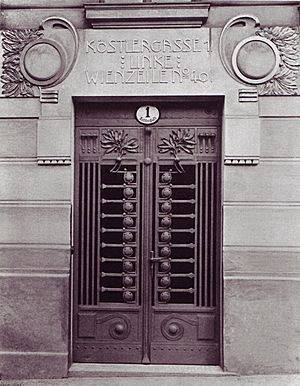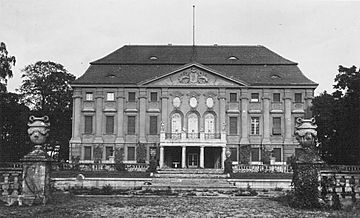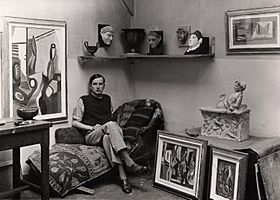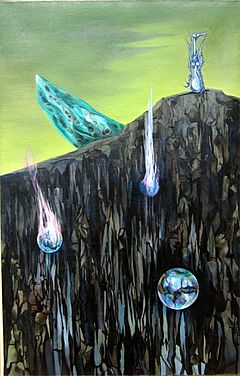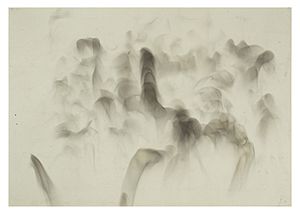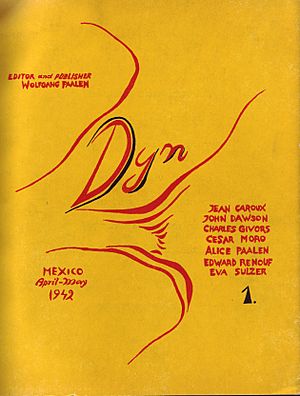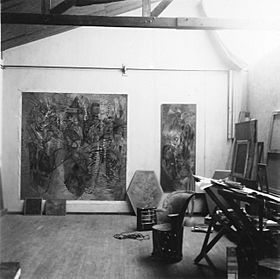Wolfgang Paalen facts for kids
Quick facts for kids
Wolfgang Paalen
|
|
|---|---|
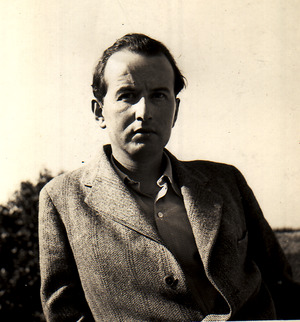
Paalen, c. 1940
|
|
| Born | July 22, 1905 Vienna, Austria
|
| Died | September 24, 1959 (aged 54) Taxco, Mexico
|
| Nationality | Austrian–Mexican |
| Education | Philosophy, art |
| Known for | Painting, sculpture, art theory |
| Movement | Surrealism, Modernism |
| Spouse(s) | 1. 1934: Alice Phillipot, later Rahon 2. 1947: Luchita Hurtado 3. 1957: Isabel Marín |
Wolfgang Robert Paalen (born July 22, 1905, in Vienna, Austria – died September 24, 1959, in Taxco, Mexico) was an Austrian-Mexican artist. He was a painter, sculptor, and someone who thought deeply about art.
From 1934 to 1935, he was part of the Abstraction-Création art group. In 1935, he joined the very important Surrealist movement. He was a key member until 1942. When he lived in Mexico, he started his own art magazine called DYN. In this magazine, he shared his ideas about art, which were different from some of the Surrealists' views. He rejoined the Surrealist group between 1951 and 1954 when he was in Paris.
Contents
Early Life and Family
Wolfgang Paalen was born in Vienna, Austria. He was the first of four sons. His father, Gustav Robert Paalen, was an Austrian-Jewish businessman and inventor. His mother, Clothilde Emilie Gunkel, was a German actress. Gustav Robert had a mix of Polish-Jewish and Spanish-Jewish family roots. He changed his last name from Pollak to Paalen in 1900.
Wolfgang's father became very rich from his inventions. These included the vacuum cleaner, the vacuum flask (known as the Thermos bottle), and an early water heater. Because of his success, Gustav R. Paalen quickly became part of the wealthy families in Vienna. He also collected famous old paintings. One of his paintings, Señora Sabasa Garcia by Francisco Goya, is now a highlight at the National Gallery in Washington.
Wolfgang spent his early years between Vienna and Styria. His father opened a fancy health resort called Tobelbad in Styria. Important people like Gustav Mahler visited there. In 1912, the Paalen family moved to Berlin and then to Silesia. His father bought and rebuilt a castle called St. Rochusburg in Sagan (now Żagań). During World War I, Wolfgang's father helped organize food supplies. Wolfgang went to different schools and had a private tutor. This tutor was an organist who loved Johann Sebastian Bach, who became Wolfgang's favorite composer.
Art Training and Family Changes
In 1919, Wolfgang's family moved to Rome. They lived in a fancy house, the Villa Caetani. Many guests visited them, including the German painter Leo von König, who became Wolfgang's first art teacher. In Rome, Wolfgang also learned a lot about Greek and Roman archaeology from his father's friend, Ludwig Pollak.
In 1923, Wolfgang went back to Berlin to try to get into an art academy, but he wasn't accepted. There, he met Eva Sulzer, a Swiss violinist and photographer. She became his lifelong friend and supporter. In 1925, he showed his art at the Berlin Secession. He also studied art theory, being influenced by thinkers like Nietzsche and Schopenhauer. He became interested in how our vision connects with the world around us.
After studying in Paris and Cassis (1925–26), where he met artists like Georges Braque, he visited an art school in Munich. In 1928, he decided to live in Paris. Around this time, his family's wealth began to decrease. Wolfgang's brother, Rainer, faced health challenges and passed away in 1942.
Paris and Surrealism
In Paris, Wolfgang briefly studied with Fernand Léger. In 1933, he joined the Abstraction-Création group, but he left in 1935. His art at this time explored how abstract shapes could still hold many meanings. He was trying to show how human sight is connected to a larger, hidden cosmic world.
In 1934, he married the French poet Alice Phillipot, who later became known as Alice Rahon. They often met with Roland Penrose and his wife, who introduced them to Paul Éluard. In 1935, Paalen met the Parisian Surrealists and their leader, André Breton. They quickly became good friends.
Breton invited Paalen to join Surrealist events. In 1936, Paalen showed his art at the Exposition surréaliste d'objets (Surrealist Objects Exhibition). He displayed a clock with glass eyes and feather hands called L´heure exacte. He also showed other objects made from roots, like Le crâne de Voltaire (Voltaire's Skull). That same year, Paalen had his own art show in Paris. Breton and Penrose also included him in the International Surrealist Exhibition in London. There, he showed paintings, drawings, and objects. He also presented his first fumage artwork, called Dictated by a Candle, which showed a ghostly hand painting.
Fumage and Famous Artworks
While working with the Surrealists, Paalen invented fumage. This is a special art technique where he used the smoke and soot from a lit candle to create interesting patterns. Between 1936 and 1937, Paalen used these smoky patterns on canvas, often painting over them with oil. These works quickly made him famous around the world.
Paalen's art explored the idea that humans are part of a big, ongoing natural and cosmic story. His painting Pays interdit ("Forbidden Land") is a key Surrealist artwork. It shows an end-of-the-world landscape with a female goddess and falling, meteorite-like planets. This painting was one of the first where he skillfully used his fumage technique in the lower part of the artwork. In 1937, he made many paintings in this style, including Fata Alaska.
International Exhibition of Surrealism 1938
In 1938, Paalen helped design the International Exhibition of Surrealism in Paris. He worked with famous artists like Marcel Duchamp, Man Ray, and Salvador Dalí. Paalen created a floor covered with dead leaves and mud. He also made an artificial pond with water lilies and reeds. He decorated a doll for the exhibition with a silk scarf, a giant bat on her head, and a dress made of mushroom-covered leaves.
Paalen's most famous object, Nuage articulé (Articulated Cloud), was also shown. This artwork was an umbrella made of sponges. It became well-known among the Surrealists. Later, it was shown in a political magazine, with a note from André Breton saying it reminded people of Neville Chamberlain's umbrella at the 1938 Munich Conference. This conference was about avoiding war, but it failed.
Besides Nuage articulé, Paalen showed other objects in the 1938 exhibition. These included Potence avec paratonnerre (Gallows with Lightning Rod) and Le génie de l'espèce (The Genius of the Species), which was a pistol shape made from small animal bones.
Plans for Mexico
In 1938, Paalen showed his new fumage paintings in Paris. The famous art dealer Marcel Duchamp recommended Paalen to Peggy Guggenheim and Julien Levy, who were important art dealers in New York. Duchamp wrote to Levy, saying Paalen's paintings looked "real" and hoped Levy would show them in New York.
After his solo show in London in 1939, Paalen decided to leave Europe. He traveled to New York in May 1939 with his wife Alice and friend Eva Sulzer. That same year, he traveled through British Columbia. There, he collected a large totem pole screen, which is now in the Denver Art Museum. His writings about this trip were later published in his magazine DYN. In September 1939, he arrived in Mexico. Diego Rivera and Frida Kahlo helped him find a house in Coyoacán, next to Kahlo's famous Casa Azul (The Blue House).
First Years in Mexico
In late 1939, Paalen helped organize the International Surrealist Exhibition in Mexico City. It opened in January 1940. In April 1940, he showed his large Fumages and new experimental, abstract works in New York. His show was very successful. Reporters said that Paalen even turned off the lights during the opening and walked around with a burning candle. Young American painters like Jackson Pollock and Robert Motherwell were there.
Back in Mexico, Paalen disagreed with his friends Diego Rivera and Frida Kahlo about their strong communist beliefs after Leon Trotsky was killed. He became more separated from Mexican leftist thinkers. However, he kept his home open to European and American visitors, including artists like Roberto Matta and Remedios Varo. He also helped refugees from Europe get visas to Mexico. During this time, Paalen focused on writing down his art ideas and secretly experimented with new painting styles in his studio.
The War Years and DYN Magazine
In spring 1942, Paalen launched his art magazine, DYN, in Mexico. The name DYN comes from a Greek word meaning "that which is possible." In the first issue, he publicly announced his "Farewell to Surrealism" to his friend Breton. In the second issue, he caused a stir by publishing an article called The dialectical Gospel, which upset the New York Surrealists.
In DYN, Paalen explored his ideas about art and possibility. He connected his ideas to quantum theory, totemism, and gestalt theory. He also criticized some Western ideas and analyzed cave painting. Through his magazine, which had five issues published between 1942 and 1944, he became one of the most important art thinkers during World War II. Even André Breton admitted in 1944 that Paalen's criticisms of Surrealism were fair.
Paalen's essays in DYN discussed important topics for young New York artists. His long article Totem Art especially influenced artists like Jackson Pollock and Mark Rothko. This was because it presented totem art as part of ancient rituals and connected it to memory and ancestor worship. Most of his essays were later published in a book called Form and Sense by Robert Motherwell.
Paalen's visits and exhibitions in New York made him known as a painter. However, because he was mostly in Mexico, and DYN was so widely read, he became seen as an intellectual who influenced the art world through his ideas.
New Ideas About Space in Painting
In the 1940s, Paalen's art played a big role in changing how people thought about abstract art. His magazine DYN and his exhibitions in New York influenced the start of Abstract Expressionism. Paintings like Les premiers spaciales (The First Spatials) from 1941 focused on creating new visual space using rhythm, light, and color. He compared the rhythm in his paintings to fugue music and jazz.
Paalen wanted his "picture beings" to create a feeling of deep, moving encounters with silent forms. He believed that the painting itself was a living thing, or a frozen echo of it. He wanted viewers to think deeply about what they saw. He believed that art should not just answer simple questions but make people ask new ones.
After the War
Interest in Ancient Cultures
In 1946, Wolfgang divorced Alice and married Luchita Hurtado, a designer and artist from Venezuela. He had met her in New York. Hurtado moved to Mexico in 1947 to live with Paalen. Together, they explored the ancient Olmec culture. Paalen later wrote a respected article about the Olmecs.
Paalen believed that the Olmecs were a peaceful culture that was eventually taken over by the more aggressive Maya civilization. He compared the Olmecs to ancient European cultures that were led by women, which were also taken over by male-led societies thousands of years ago. Paalen's ideas about ancient societies in Mesoamerica being led by women were well-supported by his research. These ideas influenced artists like Alice Rahon, Remedios Varo, and Leonora Carrington in their art about ancient and feminist themes.
San Francisco and Paris
In 1948, one of Luchita's children from her previous marriage died in Mexico. Paalen decided to move to San Francisco with his new family. There, he worked with Gordon Onslow Ford and Lee Mullican in a new group called Dynaton. They had art shows in San Francisco and at Stanford University. Paalen also gave talks about his new ideas on space in art. His desire to return to Mexico and reconnect with Breton in Paris led to his divorce from Luchita, who decided to stay with Lee Mullican.
Back in Mexico, Paalen planned a longer stay in Paris in 1951. He lived with his new fiancée, the American painter Marie Wilson, in an artist's studio building. He became friends with Breton again and spent summers at Breton's house. He helped invent new Surrealist games and painted many lyrical-abstract paintings. These were shown in Paris in 1953 and 1954. After traveling through Germany in 1954, he returned to Mexico.
Writer and Poet
Even though Paalen is mostly known as a visual artist, he also wrote poetry in French and German. He shared his poems with friends like Valentine Penrose and André Breton. In 1941, Breton loved Paalen's poetic diary about his trip to British Columbia in 1939. Parts of this diary were published in his magazine DYN.
Paalen also wrote three plays and several stories that were not published. His play The Beam of the Balance was a tragic comedy that showed the dangers of unbalanced scientific minds, especially after the atomic bombs were dropped in 1945. This play was first read publicly in 1946. His play Elorn, A Ballad from Brittany showed his lifelong interest in ancient cultures led by women.
Legacy and Art Market
The complete list of Paalen's artworks, including paintings, objects, and sculptures, was put together by art historian Andreas Neufert in his 1999 book. Paalen's personal papers and photos in Mexico were given to the Franz Mayer Museum in Mexico City. Another collection of his papers is managed by the Lucid Art Foundation in California.
From May to July 2007, some of his work was shown at the Frey Norris gallery in San Francisco. In 2014, the Wendi Norris Gallery, also in San Francisco, had a major show of his work called Wolfgang Paalen, Philosopher of the Possible.
Paalen's collected essays from DYN, titled Form and Sense, were republished in 2013. In 2019, the Belvedere, Vienna museum held a special exhibition of Wolfgang Paalen's work, which was very successful. A book about his life, Auf Liebe und Tod, was published in German in 2015 and is now being released in English in two parts.
Paalen's art is quite rare, with only about 300 paintings and a few objects and sculptures. Most of his major works are in museums or private collections. In 2009, his important 1938 fumage painting Paysage (Pays) médusé sold for about $561,000 at Christie's, setting a new record for his art. In November 2015, his painting Les Cosmogones sold for $382,000. In July 2020, his early painting Avertissement I (Peinture), 1935 sold for €387,500, setting another world record. In February 2023, two more of his Surrealist paintings, Taches solaires (1938) and Pays interdit (1936–37), set new world records at Christie's London.
Artworks
- Personnages dans une grotte, 1933
- Hommes possibles 1934
- Avertissement 1935
- L´heure exacte object, 1936
- Pays interdit 1936–37
- Rencontre sur une plage, 1936
- L'Homme possible, 1936
- Toison d'or, 1937
- La Balance, 1937
- Le Débarcadère, 1937
- Paysage totémique de mon enfance, 1937
- Nuage articulé I, objet, 1937
- Paysage totémique, 1937
- Fata Alaska, 1937
- Les Étrangers, 1937
- La Housse Mannequin 1938
- Autophage, 1938
- Orages magnétiques, 1938
- Combat des princes saturniens I and II, 1938
- Vol de moustiques, 1938
- Paysage médusé, 1938
- Les Guetteurs, 1938
- Ciel de pieuvre, 1938
- Taches solaires, 1938
- Plumages, 1938
- Le genie de l´espèce (object, 1938)
- Combats des princes saturniens, III, 1939
- Nuage articulé II (object, 1940)
- Polarités chromatiques, 1940
- Espace sans limite, 1941
- Les premieres spaciales triptych, 1941–44
- Les Cosmogonies, 1943
- La Tempête, 1945
- Gyra, 1945
- L'Or du temps, 1945
- Selam Trilogy, 1947
- Hamnur Trilogy, 1947
- Nuit tropicale, 1947
- Ancêtres à venir, 1949
- Messagers, 1949
- Fête mexicaine, 1949
- Le Messager des trois Pôles, 1949
- La Clé de Duchamp, Hommage à Marcel Duchamp, 1950
- L'enclume, 1952
- Sur les hauts plateaux, 1952
- Lumière fossile, 1953
- Le Scarabée d'or, 1953
- Béatrice perdue, 1953
- Banistas (1958)
- Asi es la vida, 1958
- Isla Mujeres, 1958
- Matutine, 1959
Essays in DYN
In English
- "The New Image", No. 1, April–May 1942
- Suggestion for an Objective Morality, in: Dyn, n° 1, April–May 1942
- Seeing and Showing, in: Dyn, n° 1, April–May 1942
- Surprise and Inspiration, in: Dyn, n° 1, April–May 1942
- About the Origins of the Doric Column and the Guitar-woman, in: Dyn, n° 2, July–August 1942
- The Dialectical Gospel, in: Dyn, n° 2, July–August 1942
- Art and Science, in: Dyn, n° 3, autumn 1942
- Book-Reviews
- Totem Art, in: Dyn, n° 4–5, 1943
- Birth of Fire, in: Dyn, n° 4–5, 1943
- On the Meaning of Cubism Today, in: Dyn, n° 6, November 1944
In French
- "Farewell au surréalisme", No. 1, April–May 1942
- L'Image nouvelle, in: Dyn, n° 1, April–May 1942
- Aperçu pour une morale objective, in: Dyn, n° 1, April–May 1942
- Paysage totémique (3 articles), in: Dyn, n° 1, April–May 1942, n° 2, July–August 1942, n° 3, autumn 1942
- Surprise et inspiration, in: Dyn, n° 2, July–August 1942
- L'Évangile dialectique, in: DYN, n° 3, autumn 1942
- Le Grand Malentendu (trad. of Art and Science), in: DYN, n° 3, autumn 1942
- Rencontre totémique in: DYN, n° 4–5, 1943
- Actualité du cubisme, in: Dyn, n° 6, November 1944
- Pendant l'éclipse, interview of Paalen with Carter Stone, in: Dyn, n° 6, November 1944
Literature
Selected Biographies
- Andreas Neufert (2014), Auf Liebe und Tod, Das Leben des Surrealisten Wolfgang Paalen (Biography), Berlin: Parthas Verlag, ISBN: 978-3869640839. (In German)
- Gustav Regler (1946), Wolfgang Paalen, New York: Nierendorf.
- Andreas Neufert (1999), Wolfgang Paalen, Im Inneren des Wals, Wien-New York: Springer, (Monography and Catalogue raisonné), ISBN: 3-211-83304-8 (In German)
- Amy Winter (2002), Wolfgang Paalen. Artist and Theorist of the Avantgarde, Westport, Connecticut: Praeger.
- Andreas Neufert: PAALEN. Life and Work, I. Forbidden Land: The Early and Crucial Years 1905 - 1939. Hamburg/Berlin 2022, ISBN: 978-3756858873 (hardcover, in English), ISBN: 978-3756820061 (softcover, in English), ISBN: 9783756826711 (e-book, in English)
Selected Exhibitions and Catalogues
- Wolfgang Paalen, Paris (Galerie Renou et Colle) 1938 (Vorwort André Breton)
- Wolfgang Paalen, London (Galerie Guggenheim Jeune) 1939
- Surrealismo, Galería de Arte Mexicano, Mexico City 1940
- Wolfgang Paalen, New York (Galerie Art of this Century) 1945
- Dynaton A New Vision, San Francisco Museum of Art, San Francisco 1951
- Domaine de Paalen, Paris (Galerie Galanis-Hentschel) 1954
- Hommage à Wolfgang Paalen, Museo de Arte Moderno, Mexico-City 1967
- Presencia Viva de Wolfgang Paalen, Museo de Arte Contemporaneo Carrillo Gil, Mexico-City 1979
- Dynaton: Before and Beyond, Frederick R. Weisman Museum of Art, Malibu (Pepperdine University) 1992
- Wolfgang Paalen, Zwischen Surrealismus und Abstraktion, Museum Moderner Kunst Wien (Ritter) 1993
- Wolfgang Paalen, Retrospectiva, Museo de Arte Contemporaneo Carrillo Gil, Mexico-City (Imprenta Madero) 1994
Reprint of DYN
- Kloyber, Christian, ed. Wolfgang Paalen's DYN: The Complete Reprint Editor's Note by Christian Kloyber; Introductory essays by Lourdes Andrade, Guy Buchholtzer, Gordon Onslow Ford, André Breton, Octavio Paz (Vienna and New York: Springer, 2000)
See also
 In Spanish: Wolfgang Paalen para niños
In Spanish: Wolfgang Paalen para niños


